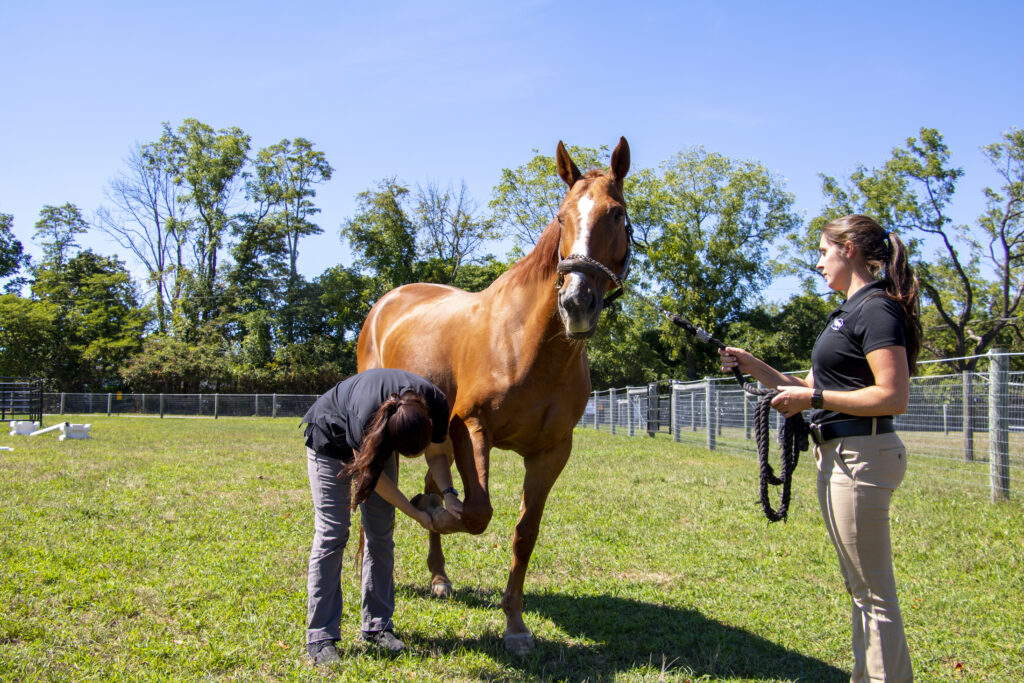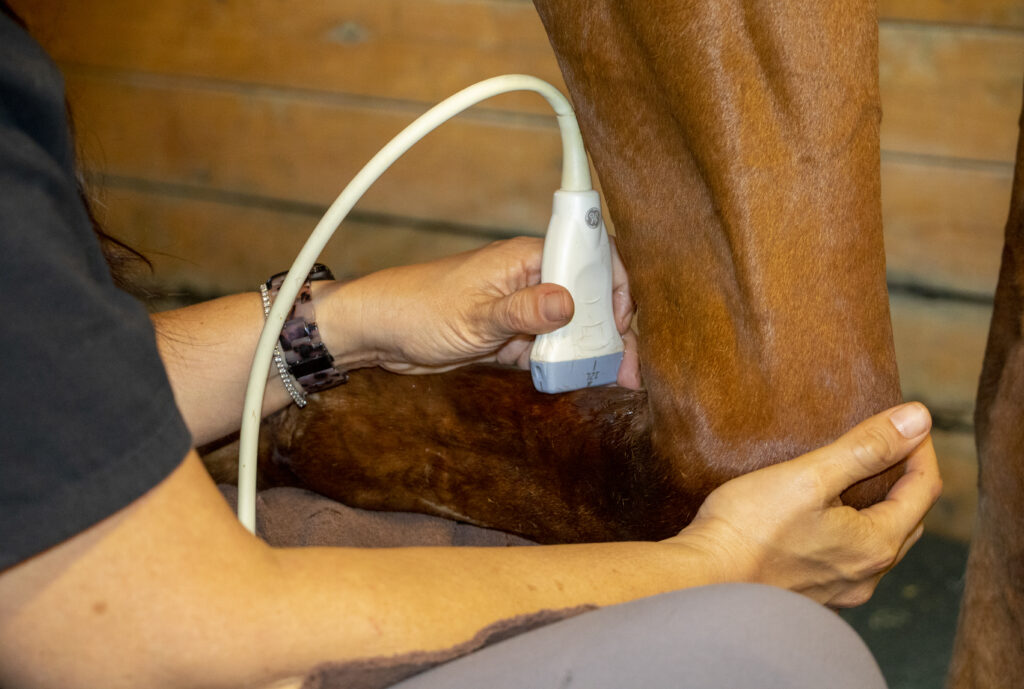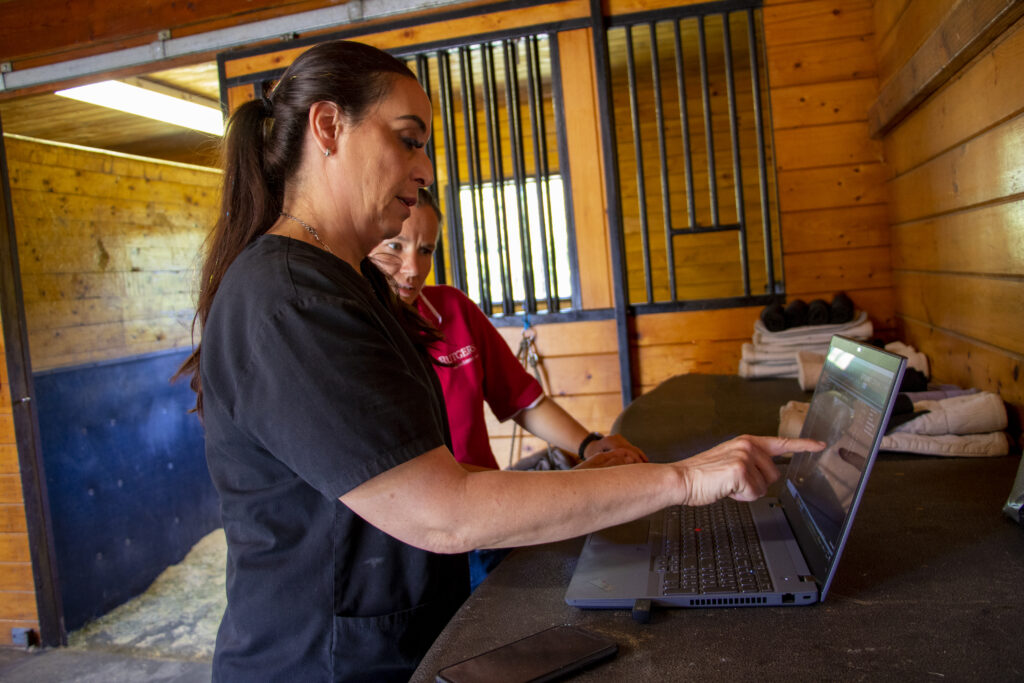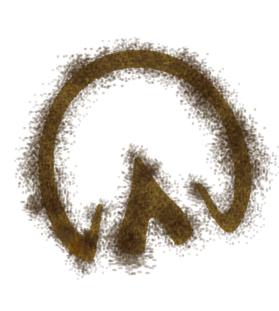Career: Veterinary Rehabilitation Specialist
Hay Everyone!
I am happy to share that I am returning to my series on careers in the equine industry. This week I traveled to Northern New Jersey to interview Dr. Sarah Gold, a veterinarian with Furlong’s Soundness Center who specializes in rehabilitation. I got to see their cool facility and equipment while I was there! The staff made sure I was warmly welcomed, and I may have even sneaked a few treats out of them! Keep reading to find out more about Dr. Gold and her team!
Lord Nelson (LN): What does a typical day at work look like for you?
Dr. Gold (Dr. G): If you asked me that question at different times in my career, it would be totally different. If you asked me fifteen years ago and said this is what you’ll be doing, I wouldn’t have believed you. I always wanted to be a very hands-on type of vet and that’s one of the reasons I joined this practice along with the mentorship and learning opportunities. Today my typical day usually involves me sitting in front of four computer screens and I’m bouncing between screens to answer questions or watching imaging going on or reviewing images or coming up with treatment plans. At the same time, I’m responding to the phone calls, the texts, and the emails that are coming through. If a referring doctor is calling me, they’re usually calling me because they need support immediately. It’s usually not going to be hard conversation. It’s usually short. It might be something as simple as they’re with the horse and owner and took an x-ray and want to know what to do next. That’s a situation I need to be available for right away. It’s trying get all those things done, which is not what I had envisioned when I started. I had envisioned the James Heriot type of experience. This work in rehabilitation is special because I get to go back to being one on one with the horse. I know each one of these horses very well and they stay with us for a while. I like to meet each horse as it is admitted because I need to get to know that horse. That is something which can be hard to translate. My colleagues can be the boots on the ground and relay the medical information, but what’s satisfying is seeing the horse on day zero and putting my hands on it and then coming up with a plan and then not looking at it as closely for a couple of weeks. I get the day-to-day relay of what’s going on, but when I see it in chunks like that, I can see the progress or lack of progress to figure out if something needs to change.
What we’re fortunate to have here is a fairly stable English Warmblood show horse population. They tend to have the same things. They tend to have the same quirks. They tend to have been managed somewhat similarly so there’s little things that you already know about that we need to take into account. What’s neat is when you see them in different time frames. When they first come in, especially if they’ve come in off the show circuit, they can come in a little quiet and you can’t read too much with them. A lot of times it is because you’re talking about an athlete that’s been dealing with something for a long time and hasn’t been quite right, so by the time they get here they’re a bit burned out. We give them quiet. There are no pagers going off and we don’t allow people on the property without appointments because we want it to be this way. It will take some of these horses a couple weeks or sometimes a month or two to settle. I think it’s two things. One, they settle into here and then two, they realize they’re not being asked to do anything that’s painful or hard and then we are responsible for making them feel better. As they start to feel better, their personalities start to come out. Some of them are really sweet and some are funny, and some are really sassy, but at least you start to see a personality because a good athlete is going to have a personality. That’s part of what gives them that fire. If you have a really high-end horse and it comes in acting like a kid’s horse, you know there’s something wrong. It should have that fire, that little explosive edge to it because that’s what makes it great. It’s gratifying to have that piece back in my life to balance out the four computer screens. I also think the unique challenges of being a horse vet in general practice is a little different. You pull up to each farm and it’s going to be a different problem or you’re going to tend to different things, so that’s one of the obvious day to day differences. The goal is actually to have an uneventful day. It should be that I’m looking at the screens, the images look great, there’s an obvious problem with a clear plan and I don’t get any messages that someone has an unexpected problem. To have a simple day is what we want and what we strive for.

Dr. Gold performing a soundness exam on one of the clients.
LN: How have you found balance in your career?
Dr. G: The young people who are coming up have taught me a lot about work life integration. Ever since I was a little kid, I wanted to be a horse vet. The cool thing about being a doctor is that your whole life you’re practicing medicine, you’re learning. I don’t think it ever really hit home for me until COVID that gunning it twenty-four hours a day, seven days a week isn’t the best thing to do. It became much more apparent to me that I needed to educate my teams and have really sharp people in place as point people who actually would do the day to day running of the businesses. The medical parts – that’s what I do. I went to school for a very long time to do that and I was very privileged to do so. I graduated without a significant amount of debt because I stayed in-state. My main point people do as much as I do. They need to understand it at a level I understand it. Then they’re just asking me some very basic clarification questions to make sure we are on the same page. It takes me a long time to create a team like that. What I need is someone who is very passionate about horses and wanting to help that individual horse. I’m a bit broader than that now because I’m trying to help multiple horses. I need someone who can look at these nine to twelve horses in the rehabilitation center and know something is good or something is bad and whether something is working. That’s what these point people do for me. Given the landscape of equine veterinary medicine at the moment, which is that there are not enough veterinarians, we need to utilize people who understand horses, who understand the discipline, who understand recovery from disease. That’s a four-year education for sure, but you don’t need eight years with an internship and a residency. Then you’re really more hands-on. I’m not really that hands-on anymore due to the volume of the caseload. If we expect the standard of care these horses deserve, horses are going to suffer from lack of veterinarians. A solution to that in the short-term and moving into the long-term is to create a team of people and respecting that team of people and really delegating the work and making sure there are redundancies in the system so that care can happen. There’s a huge need for passionate horse people who are smart and want to work hard. You don’t want to push them to burn-out, though. If I hadn’t been allowed in my career to change hats so many times, I would have reached that point of burn-out.
LN: What has the progression of your career looked like?
Dr. G: I got to do the sports medicine things – Go to the big horse shows, the Olympics, the World Equestrian Games. I learned all about eventing, which is not something I grew up with, so that was cool. The three-day eventer is a totally different kind of athlete. I grew up in the hunter/ jumper/equitation world. Eventing was a really cool thing to learn about, as those horses are amazing athletes and the teams associated with them work together in a way I have not previously appreciated. The diagnostic imaging started to become a much bigger part of my job, so we had to figure out a way where I could focus more on that and not be on the road quite as much. That shifted because I really wanted to elevate the standard of how we can image horses without anesthesia which is what we do here with the standing MRI. We also started a standing MRI business down in Florida. Managing those facilities and the teams that are associated with them and learning all about that was the next step.
Then we built the Furlong Soundness Center. Dr. Furlong had a vision to provide rehabilitative care following a sports medicine examination which oftentimes includes advanced diagnostic imaging. Then another thing I brought to the table here was regenerative medicine because I was raised on it during my internship in California. I was doing a lot with that and teaching other vets in practice how to do it. It became a very natural progression. If I’m going to be doing the imaging on the cases and then treating the cases, wouldn’t I want to follow through and manage the cases as they return to sport? That’s how I became the director of this facility. That really starts to eat into how many hours are in the day. If I look at my skillset at this point, I’m better off reviewing the images; making sure we get the right quality; making sure we get an accurate diagnosis; and then going back and talking to the horse’s primary veterinarian and advising them on what we found and having a conversation about what we ought to do. There’s a “Maserati gold standard plan” with an unlimited budget and then there’s the real-world and reality. Sometimes it’s not about the finances available to the client, but is about time which is a really precious commodity. They may have certain goals they’ve been working towards or they can only get to the barn once a day. We have to come up with a plan that will work for that situation. Rather than offering all the things, you need to come up with something that’s realistic. You’ve got to understand what the goal for that horse is. If it’s all me from beginning to end, it’s a bit more straightforward. I can help more horses by being in a bit more of a consulting role. I can work with the attending veterinarians who really know these horses’ histories. I have conversations with the entire team, the referring veterinarian, the owner, the trainer, the rider, and the farrier to figure out what will work for that particular horse. I work with the whole host of people who are important to that particular athlete to orchestrate the process and optimize success. All of those people are important and I am just a cog in the wheel.

Dr. Gold ultrasounds a horse’s foreleg to examine the tendons.
LN: What is your favorite part of your career?
Dr. G: It’s learning something new and finding inspiration within whatever that is. If you ask me that at any time, it’s probably whatever I’m doing. When I first came and was asked if I wanted to learn about the MRI, I knew I needed to find a niche within the practice, so I said sure. I didn’t think this is what I would be doing. I fell asleep in most of my imaging classes in vet school! I worked really closely with our radiologist and self-taught myself to learn what each of those images meant. At the time, there wasn’t a course for that. I started to figure out what was normal and what wasn’t. Then I moved to figuring out that something we were seeing isn’t normal, but it isn’t the problem causing the lameness. That was all really exciting.
Then Dr. Furlong wanted someone to travel the world with the high performance teams because he wanted to cut back on his traveling. Being able to travel the world with the horses at the highest level of competition was super exciting. I didn’t know when I would be coming back. They would ask, “can you meet in the horses in Virginia to go to England and then to Hong Kong?” You just go and you meet all different people and you travel. You’re traveling in a way where you’re not a tourist, you’re part of a group and you’re going to places you wouldn’t normally go. You get to integrate into these little towns and cultures. Working the with grooms you learn so much because the grooms at that level are so educated and talented. Doing all of that travel was amazing.
Then I dug in deeper with the imaging and rehabilitation. “Rehab”, from the horsemanship perspective at least, is not a new idea. The science of applying what we know in human medicine and human sports medicine to the horse is a challenge. On the other hand, where equine sports medicine was very far ahead was in the orthobiologic space of using things like PRP (plasma rich protein) and stem cells. That fundamentally started in equine medicine and then human medicine picked it up. There’s a huge exchange of ideas which is exciting.
Then I took it to the nth level of pursuing a residency in Sports Medicine and Rehabilitation and getting board certified because I wanted to understand everything that was known to this point. Through that I got to network with a whole new team of people who are doing research at the university level. I’m really inspired by the questions they’re asking. What’s interesting is at the university you have brilliant researchers who have the ability to understand data and crunch data. That’s not something I am particularly good at, but our case load is high enough that we can get the data. What do we do with it and what does it mean, though? Having those interactions and actually starting to see those patterns and publishing that information has been cool. I loved reaching that level of knowledge. I don’t recommend keeping a full time job while doing a residency. That was not good work life balance.
Getting a very complicated case and working with the attending doctors and understanding what has been done and what that horse does and then trying to put the pieces together and fill in the blanks and decide how are we going to move forward from here is rewarding. On the human side, there are athletes who have some pretty serious problems and are still competing and winning championships. It’s usually a question of how did we get here and when was the last time the horse felt good? Putting that together and coming up with a comprehensive plan to try to get back to that baseline and then how can we manage that moving forward is for sure one of my current favorite things. The more information we can get about why this was successful is really interesting. You don’t have to be a vet to do that and as a matter of fact I rely on people who aren’t to put those things together.
Part of the next step for me is how to educate people on the earlier side of it. By the time we see some of these advanced changes on imaging you’re chasing a problem that’s going to be reinjury.
LN: What is your least favorite part of your career?
Dr. G: When something bad happens to a young animal who never got much of a chance for a career. If I’m looking at imaging of a joint and I think it’s an old, cranky looking joint and then I realize that horse is only six years old. That’s not fun.
Fortunately, I’m not in a position now where I’m faced with euthanasia, although I don’t have issue with alleviating animal suffering. It’s usually more of a retirement issue in my field. I specifically chose this field because I find putting horses down hard and I’m really sensitive to it. When I see people give up on cases because it’s not financially in their best interests, that’s hard. I understand why and fundamentally, it is their horse to do with as they choose, but it’s still hard. When I see my team members having problems, that’s hard for me to deal with. I set a really high bar. I work fast and I want things done to the highest standard. When someone comes in and they’re not doing what they’re capable of, I’ve had to learn to coach them through that.
I think that we all want what’s best for the horse, but I think when you work in the high levels of sport you have to be cognizant of the fact that it might look different and you have to balance that. That’s really, really hard. To win, is not always in the athlete’s physical best interests, but that is true of any sport on the planet. The only difference is that the horse doesn’t always necessarily have the voice to say I don’t care if I win this or not. If you’re trying to do what is best for the horse and there are factors not in alignment with that, it’s really hard and that would be my least favorite part.

Dr. Gold shows Ellen the types of abnormalities she looks for on images.
LN: What advice would you give to someone wanting to pursue a similar career?
Dr. G: Go work in a barn. Go work in a high end barn because a high end, well-run barn will teach you seventy percent of what you need to know. Seventy percent of what I know as a vet is because worked as a groom. I came from a middle-class family, so when I wanted to learn how to ride I had to work for my lessons. When I wanted a horse, I had to work to pay for its board. Being in charge of those horses in the show barn taught me so much about horses and how to recognize if they’re acting normally. It will be very team oriented. It has to be if it’s going to be successful. You’ll have people to lean on. You’ll see what it takes to get there. You’ll also be privileged to be around some pretty amazing animals. That in and of itself is inspiring.
You get to travel which I think when you’re young is very important. When I think back to the traveling I did, it feels very tiring now. Horses are an unbelievable way to see the world. The professional flying grooms are amazing. I think you need to see all those things to have less questions later on about what you might want to do in the horse industry. Maybe you’ll see something that really resonates with you. That’s when you do it. When you’re young and you don’t need much sleep and you don’t have a bunch of life responsibility yet. Seeing all the different ways horses can be cared for and looked after and learning about different disciplines is important. I did all of my traveling through eventing which was not something I was familiar with or thought I would be familiar with. You just have to put in the time with the horses. The horses show you what you’re interested in. Seeing the opportunities and seeing what’s out there can help you find something that inspires you.
While you’re doing that, educate yourself and don’t limit your opportunities. The more education you have, the more opportunity you have. I don’t believe in luck. I believe in hard work and then these opportunities show themselves. Then you’re in a position to say “Yes, I want to do that.” I think you’ve got to stay super open-minded. You should work hard, be friendly, and be kind. That will open a lot of doors. If you work hard and are nice, you can kind of do anything. You need to do it with the science, though. Be a part of a team and learn all you can.
LN: What made you choose a career as a veterinarian?
Dr. G: I think the horses showed me what I was interested in. I rode and took lessons, but I was always most interested when the vet came to treat horses at the farm where I rode and groomed. I wanted to learn more about that. It gave me a clearly defined path to where I am now.
LN: Are there any other thoughts you want to share with our readers?
Dr. G: We get a lot of students who come through here and want to do “sports medicine & rehab.” I think what they need to understand is that it’s not always as exciting as it sounds. It can be. If you’re at the Olympics and the horse wins the gold medal – That’s fantastic! But most daily cases are a bit of a grind. The horse is like a slow moving barge in the water. It has been going downhill and it’s finally here, at the bottom. We need to start tipping things in a different direction. We put a plan in place and maybe it corrects a little. It takes a really long time to make big changes. Once you understand the science of healing and hitting it from all the different angles, that’s how you tip the barge. It’s still a really long process. The daily rehab of the horse shouldn’t look that exciting. What’s exciting is knowing you’re doing something really good and you’re going to wind up with a better horse than when you started. You have a responsibility to this animal and to its team to provide that result.
LN: Thanks for taking the time to visit with me and share your insights!
Dr. G: Thanks for having me, Lord Nelson. It’s always fun to talk about this topic I love and am so passionate about!
Whew, it sounds like Dr. Gold stays busy! I don’t know that I would want to have a career that keeps me that busy. You know how much I like my naps in the shade! I hope this has given you some idea of what it would be like to work in a specialized veterinarian field such as sports medicine rehabilitation.
Until Next Time.
Your Friend,

Lord Nelson
